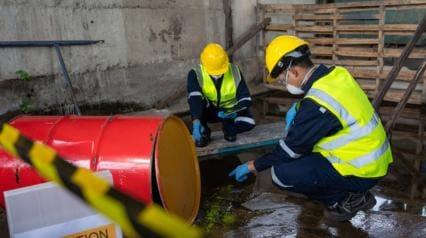What is COSHH Risk Assessment?
COSHH is an acronym for the law “Control of Substances Hazardous to Health” that requires organizations to set rules to follow in order to ensure the safe handling, transporting, processing, and disposal of hazardous substances. A COSHH risk assessment is the comprehensive process that helps teams pinpoint and determine all the hazards and risks employees face with hazardous substances.
Remember, hazardous substances can describe many different things. Some of the most obvious examples are toxic chemicals like acids, glues, and paints. However, the term also describes items that you may not automatically associate with it, like wood dust, silica shavings, and more. If your deal with these substances in the workplace, you must conduct a COSHH risk assessment to ensure that you cover all bases and determine any potential risks that you and your team face.
Importance
COSHH risk assessments are very important for managing hazardous wastes as they provide a foundation to build policies, controls, and other measures to ensure the safety of your workers. Hazardous substances can do a lot of damage when not managed properly. This is why it’s crucial for teams to understand the risks associated with their hazardous substances in full detail. From there, it’s much easier to view all the factors that may affect your worker’s safety when handling or being around these hazardous substances and you can build the right workflows and establish appropriate controls to protect your team.
The COSHH Risk Assessment Process
The reason a COSHH risk assessment is an effective way of protecting your workers is that it offers a systematic and uniform way of determining risks. That way, the playing field is even and you leave no stone unturned throughout the entire process. To give you a better idea of how it’s done, here are the different steps to conducting a COSHH risk assessment.
Identifying Hazardous Substances
The first step in a COSHH risk assessment is determining what types of hazardous substances you’re dealing with. It’s very important to be as thorough as possible during this phase and identify all the potentially hazardous substances your workers may be exposed to throughout your operations. This includes everything from hazardous chemicals all the way to harmful particles like wood shavings that they may accidentally inhale during work. During this phase, teams usually have to do a thorough inventory of all their materials and products so that they list down all potentially hazardous substances.
Performing a Risk Assessment
The next step in the process is conducting a risk assessment. This is the stage where the team evaluates all the hazardous substances and risks identified in the first step. It’s important to dive deep into the different risks and assess the risk level, how often people may be exposed to these risks, and the specific areas of your workplace where risk is at its highest. The more you know about the risks, the easier it is to apply controls and figure out the best way to keep your workers safe.
Create Your Own Risk Assessment Checklist
Eliminate manual tasks and streamline your operations.
Get started for FREEBrainstorming Control Measures
After you’ve assessed and ranked the different risks, you can start brainstorming different control measures. There are many measures you can implement to control the level of risk that your workers face. This could be beefing up the training process, requiring monitoring at all times, or even revising work procedures to improve safety. It’s important to base your control measures on the root cause of the risks to ensure that you protect your employees.
Implementing and Reviewing Measures
The last stage in the COSHH risk assessment process is implementing your control measures. From there, you’ll have to constantly monitor whether or not your measures are working and review them after some time. If you find that the control measures aren’t working as well, that’s a sign that you may have to update or revise them to improve safety.




